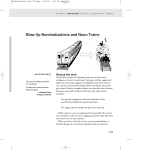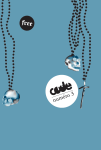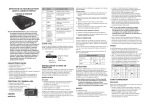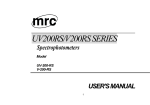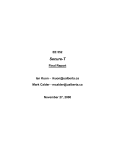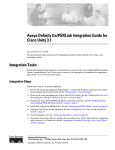Download On reducing cognitive burdens
Transcript
HotTextInterior.ch09.233.xprs H o t Te x t | 12/18/01 6:00 PM Page 204 We b W r i t i n g T h a t Wo r k s Reduce the Number of Clauses Per Sentence 206 Blow Up Nominalizations and Noun Trains 209 Watch Out for Ambiguous Phrases a Reader Must Puzzle Over 213 Surface the Agent and Action, so Users Don’t Have to Guess Who Does What 218 204 | HotTextInterior.ch09.233.xprs 12/18/01 6:00 PM Page 205 NNeett SSppiirriitt | H u m aann SSttyyle le e co ro || mm i n eg a P ro || GGeennreres s | | BBe co BBaacckkuupp chapter 9 | Idea #5: Reduce Cognitive Burdens! Make a Positive Statement, so People Understand Right Away —without Having to Unpack a Nest of Negatives 222 Reduce Scrolling 226 Let Users Print or Save the Entire Document at Once, to Avoid Reading Any More On-screen 231 | 205 HotTextInterior.ch09.233.xprs H o t Te x t | 12/18/01 6:00 PM Page 206 We b W r i t i n g T h a t Wo r k s Reduce the Number of Clauses Per Sentence Original Sentence BACKGROUND | A clause is a miniature sentence, because it contains a subject and a verb. —Robert Osgood New Sentence Move or remove that, who, and which clauses Using a that, who, or which clause lets you embed one idea inside another—and that’s excellent. Embedding a small sentence inside a larger one lets you show what is important and what is not, emphasizing one thing, demoting another, while extending the reach of your accumulating sentence so that it expresses a complex thought. But when you go too far, you have to learn to disembed sentences. Don’t let minisentences crop up right in the middle of your main sentence. When readers are moving along nicely in a sentence, but encounter a clause starting with that, who, or which right in the middle, gosh, they space out, make mistakes in understanding, and fail to recall the information inside those relative clauses. Complex syntax distracts the user from the task and taxes his or her memory. (Horton, 1990) 206 | HotTextInterior.ch09.233.xprs 12/18/01 6:00 PM Page 207 Net Spirit Remember that the matter of wordiness is entirely secondary to the matter of how your sentence sounds. When longer phrases suit the rhythm of a sentence better than short ones, the longer ones are a better choice. —Webster’s Dictionary of English Usage | H u m a n S t y le | G e n re s | B e co m e a P ro | Backup Readers seem to be built to understand one idea at a time. They get confused when they think they have grasped the general subject of a sentence, but then hear something di¤erent. Now they must hold the original thought in reserve, while contemplating a new, smaller idea, after which they must remember the original subject and apply that to the verb that emerges, just to understand who does what. So don’t let the relative clauses get between the real subject and the real verb. Strategies to handle a clause standing between a subject and a verb are: • Remove the clause altogether and turn it into a separate sentence. The risk: sounding a little dumb. • Transform the clause into an introductory if or when clause. • Move the clause to the end of the sentence, where people can digest it because better it no longer distracts from the flow of the main sentence. EXAMPLES Before After Some customers, who have already been identified Our system identifies repeat customers. They may by our system as repeat customers, may want to want to see their wish list on the first page. Also, see their wish list on the first page. The preferences our content management system ought to act that they chose earlier must be recognized, too, and on the preferences that these customers set earlier. acted on, by the content management system. Before After Now you can shop for the same items that you Now you can shop online for the same items that always liked in our paper catalog, on the Web, you always liked in our paper catalog. using our online shopping service. Before After Of all the areas of uncertainty that an asthma suf- Does the flu vaccine cause asthma attacks? ferer encounters in the research literature that has We don’t know, despite extensive research by developed over the years, as pharmaceutical com- pharmaceutical companies and the National panies and the National Science Foundation (NSF) Science Foundation (NSF). | 207 HotTextInterior.ch09.233.xprs H o t Te x t | 12/18/01 6:00 PM Page 208 We b W r i t i n g T h a t Wo r k s invest in clinical studies as to the effect of influenza . vaccinations on asthma, no question that scientists address seems as difficult to resolve as the concern that the vaccine may actually cause asthma attacks. AUDIENCE FIT If visitors want this... How well does this guideline apply? TO HAVE FUN Keeping it simple, stupid, or KISS, was developed as a guideline for business correspondence, not entertaining prose. You can play around with this rule, if you know you’re amusing. TO LEARN One idea at a time works best. Disembed, move, or remove. TO ACT One meaningful action per instruction. No more. No extra explanations, either. Just the action. TO BE AWARE If you have something profound to say, it will come out simply. On the other hand, if you are selling a cult, use more clauses, because they act like incense smoke, to blind and ensnare. TO GET CLOSE TO PEOPLE Would you use complicated syntax when talking to a friend? Probably not, unless you were pontificating—or lying. See: Bush and Campbell (1995), Creaghead and Donnelly (1982), Galitz (1985), Heckel (1984), Horton (1990), Isakson and Spyridakis (1999), Kilian (1999), Larkin and Burns (1977), Lynch and Horton (1997), Rayner, Carlson, and Frazier (1983), Roemer and Champanis (1982), Spyridakis (2000). 208 | HotTextInterior.ch09.233.xprs 12/18/01 6:00 PM Page 209 Net Spirit | H u m a n S t y le | G e n re s | B e co m e a P ro | Backup Blow Up Nominalizations and Noun Trains BACKGROUND | True ease in writing comes from art, not chance, As those move easiest who have learned to dance. —Alexander Pope, An Essay on Criticism Rescue the verb On the Web, people feel impatient with any text that seems ambiguous or hard to understand. Turning verbs like suggest and define into nouns like suggestion and definition may seem innocuous, but if you keep transforming actions into things, your prose gets clotted. Readers struggle to figure out who does what, because the prose seems full of objects with only a few fuzzy actions. Compare: Our general suggestion is that your definition of the goal should probably have greater precision. We suggest that you define the goal more precisely. Which sentence can you understand more quickly? The second one, probably. It tells you who is talking and makes clear what they want you to do. It’s more precise. When you turn a verb into a noun, you are nominalizing—a horrible thing to do. An obvious indication that you have just | 209 HotTextInterior.ch09.233.xprs H o t Te x t | 12/18/01 6:00 PM Page 210 We b W r i t i n g T h a t Wo r k s nominalized a verb is that the word gets longer, often by adding a Latinate suªx like tion, ization, or worse. But nominalizations occur whenever you make a verb do a noun’s work—even when it’s the same word. Compare: Upon the receipt of our product, please conduct a review of the contents of the box. When you receive our product, please review the contents of the box. Don’t abuse a verb by making it act like a noun. • When the nominalization trails after a nondescript verb, as in “may register improvement,” get rid of the verb and turn the nominalization into the main verb (“may improve”). • When the nominalization follows a phrase such as “There is…” lop o¤ that phrase, change the nominalization into a verb, and discover a new subject. For instance, “There is a development from our European oªce” might be changed into “Our European oªce has developed….” Untie the noun knot To compress a bunch of concepts into a single phrase, professionals often chain together a series of nouns, such as oªce design management worksheet user manual. Unfortunately, ordinary folks have trouble teasing apart the sequence, figuring out which noun goes with which other one, and what the whole shebang means. They’re often another form of jargon, a shorthanding of longer concepts. But clarity demands that the editor unpack the noun string. (Bush and Campbell, 1995) Noun strings are often ambiguous because people can consider several nouns as a unit, modifying something else, but then reconsider and see several other nouns as a complete descriptive phrase, getting an entirely di¤erent viewpoint. For instance, a reader might consider these interpretations: 210 | HotTextInterior.ch09.233.xprs 12/18/01 6:00 PM Page 211 Net Spirit | H u m a n S t y le | G e n re s | B e co m e a P ro | Backup • The manual for people who use the worksheet that lets them manage the design of their oªce. • The oªce copy of the manual explaining how to design the management of worksheet users. • The manual for worksheet users who focus on design management in oªces. Of course, without knowing more, the reader could only guess which meaning was intended. This kind of push-me-pull-you process drives people right o¤ your site. EXAMPLES Before After We’re sorry, but the product specification of the We’re sorry, but the selected printer lacks two selected hardcopy output device lacks the request- things you asked for: the LCD display and an extra- ed status indicator liquid crystal displays, as well large paper tray. as the supply feed extension mechanism. Before After There is a need for annual testing of both untreated Every year we should test both treated and untreat- water and treated water for a determination of ed water to determine the level of contaminants. contaminant levels. Before After The system model security software made an The security software investigated the attempt to investigation into the clock set violation breach. reset the system clock. Before After The intention of the site development project team Our project team intends to meet the beta dead- is to meet the beta deadline, even if that means the line, even if we have to drop some features. excision of some features. Before After Then there was a review of the file format We then reviewed the module that converts our conversion module. files to other formats. | 211 HotTextInterior.ch09.233.xprs H o t Te x t | 12/18/01 6:00 PM Page 212 We b W r i t i n g T h a t Wo r k s AUDIENCE FIT If visitors want this... How well does this guideline apply? TO HAVE FUN Noun strings are no fun. Neither are those other thingamajigs. TO LEARN Obscure and ambiguous. Definitely a no-no. TO ACT Follow the guideline to make sure people know what to do. TO BE AWARE Self-defeating to use. TO GET CLOSE TO PEOPLE Use nominalizations to be one-up on the poor bastards. Noun trains just baffle anyone who doesn’t already understand you completely. See: Bush & Campbell (1995), Horton (1990), Price & Korman (1993), Tarutz (1992), Waite (1982), Williams (1990). 212 | HotTextInterior.ch09.233.xprs 12/18/01 6:00 PM Page 213 Net Spirit | H u m a n S t y le | G e n re s | B e co m e a P ro | Backup Watch Out for Ambiguous Phrases a Reader Must Puzzle Over BACKGROUND | Time flies like an arrow. Fruit flies like a banana. —Groucho Marx When a word can be taken two ways… Sometimes, we let a word fall between two phrases—it could refer to either topic, and the reader has to puzzle out which way we meant. Figuring out an ambiguity is always a nuisance, but online, where people have less patience than they exhibit reading a newspaper, such uncertainties make people mad. Anything that drives your readers to debate about what you might have intended, distracts them from your point, and risks heading them in the wrong direction—like o¤ your site. The amount of thinking that the user has to put in, just to move around the Web site, already burdens the mind. Add to that the barely recalled sequence of pages coming here, and now you are waving puzzle pieces in the readers’ faces saying, “Which one did I really mean?” To reduce what Morkes and Nielsen call “cognitive load,” be concise, scannable, and unambiguous. | 213 HotTextInterior.ch09.233.xprs H o t Te x t | 12/18/01 6:00 PM Page 214 We b W r i t i n g T h a t Wo r k s Beware modifiers that point forward and backward Consider this sentence: Overdoing your fitness routine seriously results in aches and pains. That seriously raises a little uncertainty. Does this sentence mean that seriously overextending yourself can result in aches and pains? Or does the author mean that overexertion must always lead to serious aches and pains? To avoid unintended double entendres, try these strategies: • Watch out for adverbs and adjectives that might be taken to modify two di¤erent phrases—one before, and one after. • Place an adverb near its verb. • Place an adjective before its noun, not after. It’s not a sandwich, except in San Francisco In the Bay Area, the It’s It is a patty made out of chocolate wafers with ice cream sandwiched in between. Delicious. But online, where no one knows what it is, beware of pronouns. People have to think a bit to see what the pronoun refers back to. If you give them two or three possible referents, the mind gets dizzy, and the finger clicks away. So be attentive whenever you realize you have just perpetrated a long sentence or paragraph carrying a lot of nouns and di¤erent pronouns, such as: Marketing mavens addressing their prime customers are vitally concerned about their goals, and they are equally concerned with understanding how features relate to benefits and their own objectives. Who’s they? Sorting out your own pronouns is a service to your readers. Strategies: • Repeat the darn noun. At first the repeated noun sounds clunky, even boring. But as Gerry McGovern says, “Boring is beautiful on the Internet, because the Internet is a very functional place.” • Move the pronoun so it is close to the noun referred to. 214 | HotTextInterior.ch09.233.xprs 12/18/01 6:00 PM Page 215 Net Spirit • One keeps saying the same thing, but the fact that one has to say it is eery. —Elias Canetti, • | H u m a n S t y le | G e n re s | B e co m e a P ro | Backup Use the pronoun only one way in the sentence. If you find three uses of it, make sure it always refers to the same noun. Make the noun explicit. Don’t imply a general topic and then refer broadly to “it.” You’re making readers guess what you mean, and they may guess wrong. The Human Province Don’t point offstage On the Web, you can’t assume you know where guests have come from, so suggesting they go back to a page they have never seen may seem odd, or raise unpleasant thoughts, even anxiety in some guests. Watch out for relative directions, particularly when borrowing material that was originally written for paper, where forward, above, below, and back all have real meaning. Describe the subject of the page, or use absolute directions. (Jutta Degener, quoted by Levine, 1997) Ixnay on the creative variations In a poem designed to be read on paper, we may struggle to find new words to describe the same object, giving the reader new perspectives, new slants, and new overtones. In literature, consistency stinks. Oscar Wilde called it “the last refuge of the unimaginative.” Aldous Huxley said, “The only completely consistent people are dead.” So go ahead, be inconsistent in life—and poetry. But when you write practical Web prose, adopt Gertrude Stein’s maxim, “A rose is a rose is a rose.” Changing the word you use to describe the rose could make people wonder whether you have begun talking about some new flower altogether. How can users follow a procedure if the terminology changes, if you call something a screen one time and a window the next? It’s not the user’s job to figure out what you mean. It’s your job to make it obvious. (Henning, 2001d) | 215 HotTextInterior.ch09.233.xprs H o t Te x t | 12/18/01 6:00 PM Page 216 We b W r i t i n g T h a t Wo r k s If you call a gizmo a stylus here, don’t start referring to the same thing as a pen. If you use the word user to refer to a consumer in one paragraph, don’t switch in the next paragraph, and write user when you really mean developer. Adopt a controlled vocabulary—a list of terms your team agrees to use, consistently, throughout the site. By predetermining the terms that make up a controlled vocabulary, and using those terms to describe your site’s content, you can minimize the negative e¤ects that variants, synonyms, and various other annoyances can have on your site and its users. (Rosenfeld, 1999) EXAMPLES Before After You’ll find that information at the top. You’ll find that information on our home page. …as shown in the table below. … as shown in the table. If you go forward, you’ll … In the System White Paper, you’ll On the next level up, look for … In the Security Overview, look for Below this section…. In the subsection on The Protocol Recommendations Next Next: Our extension of this study, Further Thoughts Previous Previous: The authors’ initial report We put 12 rosebuds coated with chocolate entirely Once a month, we send you 12 rosebuds entirely on your monthly subscription. coated with chocolate, throughout your subscription. 216 | HotTextInterior.ch09.233.xprs 12/18/01 6:00 PM Page 217 Net Spirit | H u m a n S t y le | G e n re s | B e co m e a P ro | Backup The families in our cooperative make 100% Scottish The families in our cooperative make 100% Scottish cashmere apparel. It creates kilts, capes, scarves, cashmere apparel. We create kilts, capes, scarves, sweaters, pullovers, blankets, and throws. These sweaters, pullovers, blankets, and throws. You can items are available direct from them, through our buy these items direct from individual families, secure ordering pages. Click to see them. through our cooperative’s secure ordering pages. The new window may have appeared right on top The new page may have appeared right on top of of the original page, so that you can no longer see the original page, obscuring it. that frame. AUDIENCE FIT If visitors want this... How well does this guideline apply? TO HAVE FUN Ambiguity may be part of the game. Just make sure you signal your guests that you are being deliberately provocative, not just lazy. TO LEARN Half your effort is simply avoiding ambiguity. TO ACT Don’t make someone pause in mid air, wondering whether you mean A or B. TO BE AWARE Poetry and parables work on several levels, referring to different planes of experience. But on each plane, the best lines are unambiguously powerful. TO GET CLOSE TO PEOPLE In a direct exchange, people overlook accidental ambiguities, if they think they know what you mean. Strangers, though, may choose the worst possible interpretation and send you flames. See: Fowler, Aaron and Limburg (1992), Henning, (2001d), Horton (1990), Kilian (1999), Levine (1997), McGovern (2001), Morkes and Nielsen (1998), Price and Korman (1993), Rosenfeld (1999), Tarutz (1992), Williams (1994). | 217 HotTextInterior.ch09.233.xprs H o t Te x t | 12/18/01 6:00 PM Page 218 We b W r i t i n g T h a t Wo r k s Surface the Agent and Action, so Users Don’t Have to Guess Who Does What BACKGROUND | Write actively, to speed people’s understanding People habitually think in terms of characters carrying out actions that a¤ect objects or other people. So readers expect this pattern in sentences: Character or actor = Subject Action = Verb Object = Direct object Williams says readers think prose is clear when: (1) The subjects of the sentences name the cast of characters. (2) The verbs that go with those subjects name the crucial actions those characters are part of. (Williams, 1990) 218 | HotTextInterior.ch09.233.xprs 12/18/01 6:00 PM Page 219 Net Spirit The interest to myself would seem to have been, as I recover the sense of the time, that of all the impossibilities of action, my proceeding to Cambridge on the very vaguest grounds that probably ever determined a residence there might pass for the least flagrant; as I breathe over again at any rate the comparative confidence in which I so moved I feel it as a confidence in the positive saving virtue of vagueness. Could I but work that force as an ideal I felt it must see me through, for the beauty of it in that form was that it should absolutely superabound. I wouldn’t have allowed, either, that it was vaguer to do nothing; for in the first place, just staying at home when everyone was on the move couldn’t in any degree show the right mark; to be properly and perfectly vague one had to be vague about something; mere inaction quite lacked the note—it was nothing but definite and dull. —Henry James, Notes of a Son and Brother | H u m a n S t y le | G e n re s | B e co m e a P ro | Backup But writing in the passive voice turns that pattern on its head. A passive sentence turns the object into a subject, and deletes the true actor, or pushes that person o¤ into a prepositional phrase toward the end of the sentence. Active: The batter hit the ball. Passive: The ball was hit by the batter. Some readers may actually encode the passive text in active voice, to understand it. Reading a passive sentence like “The chocolate sauce was poured over the raspberry by the chef,” the mind evidently pauses to translate that into “The chef poured chocolate sauce over the raspberry.” Now the main actor has become the true subject of the sentence, matching the mind’s expectations, and the object of her pouring has ended up where it belongs—as the object of the verb. And the active verb shows us what the lead actor does. The chocolate sauce is no longer acting as if it were the person in charge. This process of translation adds 25% to the time required to understand the sentence. Not only do readers move more quickly through activevoice text, but they prefer it and feel more familiar with it. (Spyridakis, 2000) Of course, some minds just enjoy thinking about chocolate, so those folks may not object to the split seconds devoted to reinterpreting the sentence. And in science, engineering, bureaucracies, and academia, the passive voice sounds sober and professional in research papers. But online, that paper mentality takes too many words, and eats up too much thinking time. If your users are just going to download and print a document, you don’t need to change the passive voice. But if your audience will try to read the material online, you should transform all those weak-kneed passives into healthy, active sentences. 1. Make the actor the subject (the batter). 2. Change the verb to active voice (from “is hit by” to “hits”) 3. Move the object (the ball) after the verb. | 219 HotTextInterior.ch09.233.xprs H o t Te x t | 12/18/01 6:00 PM Page 220 We b W r i t i n g T h a t Wo r k s Is is OK? Occasionally, you have to define a term, or create an equation. Literature is news that stays news. (Ezra Pound, ABC of Reading, 1934) Mediocrity is a handrail. (Montesquieu, Mes pensées, 1755) The verb is acts as the equal sign. That’s OK. The verb to be is not, in itself, passive. The passive crops up when you turn the subject into a victim, being operated on by the verb. EXAMPLES Before After If disks are swapped with others, or picked up at A virus could infect your disk if: flea markets, it must be noted that viruses could be a problem on the disks; the same is true if disks are received from people whose game software • • • has been downloaded from the Internet, or if software gets loaded on the disk after being downloaded from unknown sites. 220 | You swap disks with friends. You pick up disks at flea markets. You receive disks from people who download games from the Internet. • You download software from people you don’t know. HotTextInterior.ch09.233.xprs 12/18/01 6:00 PM Page 221 Net Spirit | H u m a n S t y le | G e n re s | B e co m e a P ro | Backup AUDIENCE FIT If visitors want this... How well does this guideline apply? TO HAVE FUN An occasional passive voice does no one any harm. But get in the habit, and you put your readers to sleep. TO LEARN Passives are OK when there is no true subject. Avoid them when you want to help students understand concepts, processes, or ruling principles. TO ACT Follow the guideline to be clear. Better yet, write in the imperative. Tell people what to do. Give orders! TO BE AWARE Some passives reflect reality. The person does nothing, but is transformed. Still, keep the passives to a minimum. TO GET CLOSE TO PEOPLE Somehow, folks know you are covering up, exaggerating, or lying when you overuse the passive—they’ll say you sound just like a bureaucrat. See: Broadbent (1978), Flower, Hayes, and Swarts (1983), Henning (2001c), Herriot (1970), Horton (1990), Kilian (1999), Kintsch (1993), Miller (1962), Spyridakis (2000), Tarutz (1992), Williams (1990). | 221 HotTextInterior.ch09.233.xprs H o t Te x t | 12/18/01 6:00 PM Page 222 We b W r i t i n g T h a t Wo r k s Make a Positive Statement, so People Understand Right Away—without Having to Unpack a Nest of Negatives BACKGROUND | Negatives slow people down Faced with a negative, readers must often translate it into a positive statement to figure out what it means. The world’s as ugly, ay, as sin And almost as delightful. —Frederick Locker-Lampson, The Jester’s Plea 222 | Comprehension su¤ers when the reader must make a logical reversal, such as when translating the statement “The switch is not o¤” to get the meaning “The switch is on.” (Simpson and Casey, 1988) Negative words, especially two in a row, require more e¤ort from the reader to understand, causing information overload. (Sammons, 1999) HotTextInterior.ch09.233.xprs 12/18/01 6:00 PM Page 223 Net Spirit | H u m a n S t y le | G e n re s | > >> > Do the translation for your guests. • not many • not the same • not strong enough • did not remember B e co m e a P ro | Backup few di¤erent too weak forgot One negative is bad, but two or three will confuse anyone Avoid combining no, not, or never with verbs that give o¤ negative vibes, like avoid, deny, doubt, exclude, fail, lack, prevent, or prohibit. First, the reader has to figure out what positive action may have been attempted or asserted. Then the reader has to understand how the action got stopped. And finally, the not appears, turning the stop-action back on itself. Beware, too, words that are implicitly negative, such as unless, however, without, against, lacking. • The cancellation form was not accepted by the server. Please do not retry at this time unless the text in fields marked with red arrows has been erased. • The filtering criteria you submitted have not been rejected, but failed to exclude any known sites. To completely confuse your readers, combine negatives with passive verbs and our dreaded nominalizations. • Returns must not be sent unless a cancellation process has been refused. • We’re sorry but privacy concerns cannot be addressed individually, except in non-secure e-mail transmissions. If you must say NO, say why Sometimes, you just have to say “No!” If you have to contradict an idiot, deny a statement, or fight against a misunderstanding, go ahead. But rush in afterward with a positive statement. • We’re not geeks. We’re just ordinary consumers, like you. • No surrender! We’re going to go on fighting for the environment. | 223 HotTextInterior.ch09.233.xprs H o t Te x t | 12/18/01 6:00 PM Page 224 We b W r i t i n g T h a t Wo r k s Take a positive stance Making a positive statement takes more imagination. Instead of telling people, “Don’t operate in an unsafe manner,” you have to think what safe operation consists of. That takes more e¤ort than merely waving your hand and saying, “Don’t get in trouble.” But if you can come up with concrete actions that users can take, you increase the likelihood that they will follow your advice. Which sentences would you find easier to act on? Negative Don’t put tools on the floor. Don’t overload the power supply with nonstandard voltages. Overboiling could have a negative impact on taste and texture. Positive Put tools on the table. Use only 220 volt power. Boil for 7 minutes, then drain, for best taste and tex- EXAMPLES Before After Caution: do not reject this offer to cancel unless Please reconsider your resignation. We want you as you have already discounted the many benefits a member, and hope you value the many benefits of membership. of membership. To stay a member, click Stay. Before After Except when verification of income cannot be made To make sure your application is approved, because of lack of documentation, applications will please send us documentation so we can verify not be denied. your income. 224 | HotTextInterior.ch09.233.xprs 12/18/01 6:00 PM Page 225 Net Spirit Before | ture. We cannot agree with those negative people who H u m a n S t y le | G e n re s | B e co m e a P ro | Backup After We cannot agree. We believe in freedom of speech. unaccountably deny the reality of freedom of speech. Before After However often the secure server has identified a The administrator must always have access to the break-in, it would not be advisable to prohibit secure server—even if a hacker has broken in. administrative access. AUDIENCE FIT If visitors want this... How well does this guideline apply? TO HAVE FUN Taking a negative position intrigues your readers. But attack with gusto and not too many negatives. TO LEARN Negatives rarely work. Teach pluses, not minuses. TO ACT People need to know what to do. Telling them what not to do risks confusion, or worse, people doing just what you told them not to do. TO BE AWARE Try not thinking of fudge. Negatives have their place when you must disabuse people of established notions. But move quickly to what is true. TO GET CLOSE TO PEOPLE A few negatives get a good argument going. Too many, and people tune out. See: Boomer (1975), Chase & Clark (1972), Clark & Chase (1972), Dewer (1976), Hackos & Stephens (1996), Herriot (1970), Horton (1990), Sammons (1999), Simpson & Casey (1988), Whitaker & Stacey (1981), Wickens (1984), Williams (1990, 1994). | 225 HotTextInterior.ch09.233.xprs H o t Te x t | 12/18/01 6:00 PM Page 226 We b W r i t i n g T h a t Wo r k s Reduce Scrolling Scrolling disorients some people You’ve had the experience. You scroll down, down, down—and discover you’ve gone past the topic you were looking for. So you scroll up, up, up—and go past it again. Plus, once you’ve located and read the topic, you may not be sure where you are on the full page. Excessive scrolling can disorient computer users. Information that has scrolled o¤ the screen is invisible, and therefore harder to remember. (Lynch, 2000) Readers tend to remember where topics occur within the layout of a printed page. That memory is reinforced by the fact that an item stays put as the person reads through the page. But on the 226 | HotTextInterior.ch09.233.xprs 12/18/01 6:00 PM Page 227 Net Spirit | H u m a n S t y le | G e n re s | B e co m e a P ro | Backup Web, scrolling moves the item, pushing it out of sight, leaving users uncertain how long the page may be, and where the item may fall within its layout. Users can only see how the item relates to its nearest neighbors. With a fuzzier image of the item’s place in the overall structure of the page, people have more trouble remembering the point. Very long Web pages tend to be disorienting, because they require the user to scroll long distances, and to remember the organization of things that have scrolled o¤-screen. (Lynch and Horton, 1997) For most people interviewed, paths were the predominant city elements, although their importance varied according to the degree of familiarity with the city. People with least knowledge of Boston tended to think of the city in terms of topography, large regions, generalized characteristics, and broad directional relationships. Some people don’t scroll at all When Jakob Nielsen first studied users, back in the early days of the Web, he found that only 10% of them would scroll “beyond the information that is visible on the screen when a page comes up” (1996). Year by year, more users are willing to scroll, at times. But many don’t bother to scroll below the top of the page. Many participants want a Web page to fit on one screen. (Morkes and Nielsen, 1997) —Kevin Lynch, The Image of the City Pack the top The most important part of your site is the top of the page. That’s the only area you can be sure your users will see. So show it o¤. Avoid requiring users to scroll in order to determine page contents. Users should be able to recognize immediately whether the subject of any given page interests them. (IBM, 1999) Move up any information that you absolutely want to get across. For presentations that must grab people’s attention to be successful, don’t make the page longer than the window. (Levine, 1997) | 227 HotTextInterior.ch09.233.xprs H o t Te x t | 12/18/01 6:00 PM Page 228 We b W r i t i n g T h a t Wo r k s No scrolling menus, please The point of a menu is to let people choose between various options. When some of the options disappear, or never appear, the users have to guess, remember what they scrolled by, and they may make the wrong choice, and end up on irrelevant or dud pages. Most navigation pages should not scroll. (Microsoft, 2000) But if you have a long list of links that form a single conceptual unit, such as a list of football teams or cities, you can allow scrolling because once people figure out the organizational scheme, they know how to troll for the link they want. When scrolling is OK Destination pages can go long. When users find the first screen interesting, they will deign to scroll through a few more screens of text. But not many. Users will almost never scroll through very long pages. (Nielsen, 1999f) Try rewriting to make the whole page shorter. Consider breaking the piece up into a series of shorter chunks, linked together. If you decide that the piece really hangs together as a single unit, show the whole article on one page. Users may dislike scrolling, but they hate waiting for another download. Content pages should contain one conceptual unit of content. In general, people prefer to scroll to continue a single unit of content like an article, skit, or short story, rather than click from page to page of an article. (Microsoft, 2000) If you have a page that people will want to read at length, a scrolling page is tolerable. But you might provide a printer-friendly version, as we suggest in the next guideline. 228 | HotTextInterior.ch09.233.xprs 12/18/01 6:00 PM Page 229 Net Spirit | H u m a n S t y le | G e n re s | B e co m e a P ro | Backup Before Navigation Bar Topic Menu About our Interface A lot of people see interfaces as just cosmetic, you know, coming afterward, putting a pretty face on the whole product, but not ours. Our interface is not an afterthought. A lot of engineers talk about interface design as if it is all decided in Redmond; whatever Microsoft says, we do that, and, voila, we have an interface. that is not true. Bill says. But You don't have to do what We are more like Mac designers. We see interface as a major part of the product. We work just as hard-early- Screen Limit developing an interface that will be fun as we do developing the combinatorial math that underlies the feature set. We see the interface as a kind of artistic environment. The user is visiting us for the first time, maybe, and we want to show that we encourage exploration, play. That is why everything is one click away. Click and go. Also, everything is reversible. No matter what you do, you can undo. Now some of the pros scoff at our interface, because it makes the process, well, too easy. Tough. For us, if you can't play when you're making art, you should go into accounting. After Navigation Bar Topic Menu About our Interface Our interface is not an afterthought. We work just as hard developing an interface as we do developing the combinatorial math that underlies the feature set. We see the interface as a kind of artistic environment. The user is visiting us for the first time, and we want to show that we encourage exploration. Everything is one click away. Click and go. For us, if you can't play when you're making art, you should go into accounting. | 229 HotTextInterior.ch09.233.xprs H o t Te x t | 12/18/01 6:00 PM Page 230 We b W r i t i n g T h a t Wo r k s AUDIENCE FIT If visitors want this... How well does this guideline apply? TO HAVE FUN People who really, really like to read are willing to immerse themselves in very long pages, and prefer reading those to hopping about among arbitrarily short chunks. On the other hand, many people enjoy the breather they get when downloading the next short passage. Play scrolling any way you like. TO LEARN If you want someone to learn online, the short chunks work best. If you expect students to print and read off paper, who cares how long the page is? TO ACT Out of sight, out of action. Instructions that scroll always lose people. Try to get all the key steps in view at the same time. If not, work within two or three screens. TO BE AWARE Scrolling is a religious issue. Practice not getting self-righteous pro or con. TO GET CLOSE TO PEOPLE Whatever you write in the first screen determines whether I am willing to go on. In most cases, you should be able to say what you have to without going on and on and on. See: Black & Elder (1997), Dillon (1994), IBM (1999), Farkas and Farkas (2000), Levine (1997), Lovelace and Southall (1983), Lynch (2000), Lynch and Horton (1997), Microsoft (2000), Morkes and Nielsen (1997), Nielsen (1997, 1999f), Rothkopf (1971). 230 | HotTextInterior.ch09.233.xprs 12/18/01 6:00 PM Page 231 Net Spirit | H u m a n S t y le | G e n re s | B e co m e a P ro | Backup Let Users Print or Save the Entire Document at Once, to Avoid Reading Any More On-screen BACKGROUND | Our host has filled many notebooks with the sayings of our fathers as they came down to us. This is the way of his people; they put great store upon writing; always there is a paper. —Four Guns Archive the printer-friendly version If you have a lot of little chunks making up a long document, o¤er people a separate page containing the whole document, formatted just for printing. That way, users can save and print without having to jump through dozens of links to see individual portions of the document. Most users will save long documents to disk or print them rather than read extensive material online. (Lynch and Horton, 1997) If the document is long, and built as a linear sequence, its natural medium is paper. You are just delivering that document to the user’s printer. | 231 HotTextInterior.ch09.233.xprs H o t Te x t | 12/18/01 6:00 PM Page 232 We b W r i t i n g T h a t Wo r k s Long, linear-text documents really belong back on paper. Your web site is just an archive for them. (Kilian, 1999) See: IBM (1999), Kilian (1999), Levine (1997), Lynch & Horton (1997). POST | Express your own idea on: [email protected] My Idea: Subscribe: [email protected] Unsubscribe: [email protected] Post to [email protected] Visit: http://www.WebWritingThatWorks.com 232 |





























